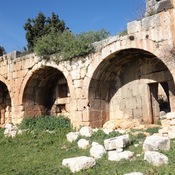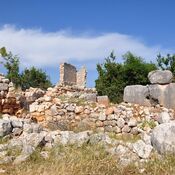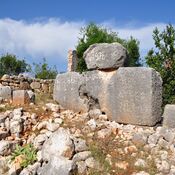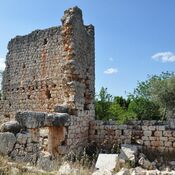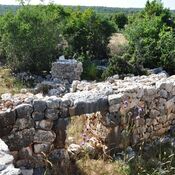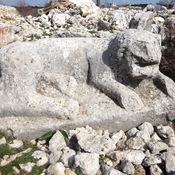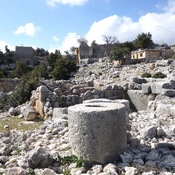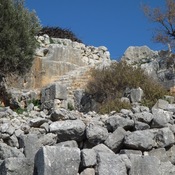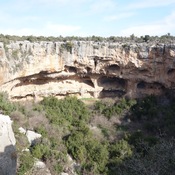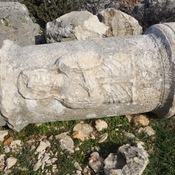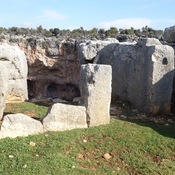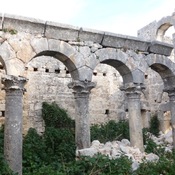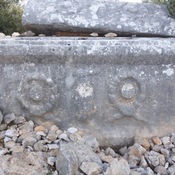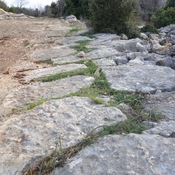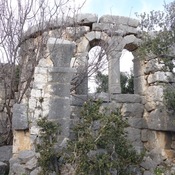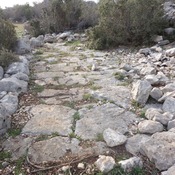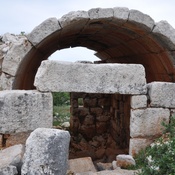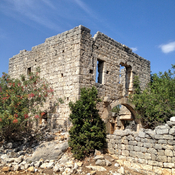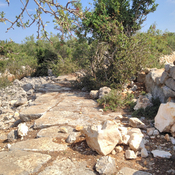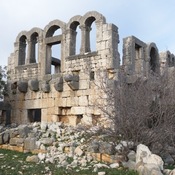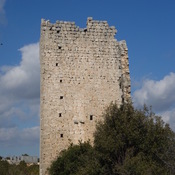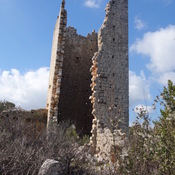Paslı is situated in Olba’s territorium in the eastern part of Rough Cilicia, about 10 km. northwest of the ancient coastal city of Korasion. It sits on the east bank of the valley, through which the Yenibahçe Stream flows. The remains extant in the settlement suggest that this was one of the fortresses built in the region during the Hellenistic period and survived during the post-Hellenistic period. Although some of the Hellenistic findings have appeared in publications, studies about the Roman period with its rich archaeological remains have been very limited. Regarding Late Antiquity, while the number of remains increases and the settlement grows, remains from previous periods have been destroyed. All the same, it is evident that the settlement acquired a rural character in line with the historical process begin- ning from the Roman period. Among the remains in the site, the ones that stand out are the tombs and monumental tombs. Their rich variety may be observed by looking at various type of architecture. Our surveys reveal that both the western and northern slopes facing the valley were used as necropoleis containing different types of tombs. Among them are monumental tombs with aediculae, sarcophagi with hyposorium, chamosoria, rock sacrophagi and monumental tombs with podiums. Six olive oil workshops have been identified in Paslı. Both the masonry and the location of these facilities indicate that they were additional structures added after the Hellenistic period reflecting the rural character that the settlement assumed in this period. In the northern part of the settlement in Paslı right out- side the fortification wall, the remains of a large dwelling structure were found. Throughout the settlement around 50-60 dwellings can be discerned. However, due to heavy destruction, their plans cannot be retrieved. Still, paved street and rockcut steps on the slope are evidence for a certain arrangement among them. On the other hand, we should rather consider that these dwellings belonged to the final stages of the settlement. It is not possible to distinguish the ones dating from the Hellenistic and the Roman periods. Gathered archaeological evidence provides information regarding the planning of the ancient village settlements in the region. These set- tlements comprise buildings constructed in close proximity with each other within a limited area. The houses have a courtyard with a cistern and presses hewn into bedrock. Although the amount of documented archaeological evidence of rural set- tlements of the Hellenistic period is marginal, a large number of rural settlements particularly of the Roman and early Byzantine periods, have been identified, thus pointing to the presence of settlement organization. Some conclusions are pos- sible, regarding the dating of the use of the buildings and constructions in Paslı. Examples of monumental tombs in the site can be dated to the second half of the 2nd century A.D and this is important in showing the fact that the rural character was continuing at that period. The installations, documented at the farms, support this historical development, and their specific characteristics support increases in this continuous production activity in the region, particularly starting in the 3rd century A.D. From the very high number of documented archaeological finds in the region it would appear that production activities became more intense, particularly in the late Antiquity period and continued into later periods.
Aydinoglu, Ü., Paslı: The Process of Change of a Rural Settlement in Rough Cilicia., OLBA XXI., Mersin University Publications., Mersin., 2013.
Localisation:
- Turquie, Öztürkmenli
- geo:36.467869,34.004875
- Précision ± 0-5 m.
Period or year:
- -3xx / unknown
Classification:
- Habitat rural
- Visible
Identificateurs:
- vici:place=20004
Annotations
Paslı is situated in Olba’s territorium in the eastern part of Rough Cilicia, about 10 km. northwest of the ancient coastal city of Korasion. It sits on the east bank of the valley, through which the Yenibahçe Stream flows. The remains extant in the settlement suggest that this was one of the fortresses built in the region during the Hellenistic period and survived during the post-Hellenistic period. Although some of the Hellenistic findings have appeared in publications, studies about the Roman period with its rich archaeological remains have been very limited. Regarding Late Antiquity, while the number of remains increases and the settlement grows, remains from previous periods have been destroyed. All the same, it is evident that the settlement acquired a rural character in line with the historical process begin- ning from the Roman period. Among the remains in the site, the ones that stand out are the tombs and monumental tombs. Their rich variety may be observed by looking at various type of architecture. Our surveys reveal that both the western and northern slopes facing the valley were used as necropoleis containing different types of tombs. Among them are monumental tombs with aediculae, sarcophagi with hyposorium, chamosoria, rock sacrophagi and monumental tombs with podiums. Six olive oil workshops have been identified in Paslı. Both the masonry and the location of these facilities indicate that they were additional structures added after the Hellenistic period reflecting the rural character that the settlement assumed in this period. In the northern part of the settlement in Paslı right out- side the fortification wall, the remains of a large dwelling structure were found. Throughout the settlement around 50-60 dwellings can be discerned. However, due to heavy destruction, their plans cannot be retrieved. Still, paved street and rockcut steps on the slope are evidence for a certain arrangement among them. On the other hand, we should rather consider that these dwellings belonged to the final stages of the settlement. It is not possible to distinguish the ones dating from the Hellenistic and the Roman periods. Gathered archaeological evidence provides information regarding the planning of the ancient village settlements in the region. These set- tlements comprise buildings constructed in close proximity with each other within a limited area. The houses have a courtyard with a cistern and presses hewn into bedrock. Although the amount of documented archaeological evidence of rural set- tlements of the Hellenistic period is marginal, a large number of rural settlements particularly of the Roman and early Byzantine periods, have been identified, thus pointing to the presence of settlement organization. Some conclusions are pos- sible, regarding the dating of the use of the buildings and constructions in Paslı. Examples of monumental tombs in the site can be dated to the second half of the 2nd century A.D and this is important in showing the fact that the rural character was continuing at that period. The installations, documented at the farms, support this historical development, and their specific characteristics support increases in this continuous production activity in the region, particularly starting in the 3rd century A.D. From the very high number of documented archaeological finds in the region it would appear that production activities became more intense, particularly in the late Antiquity period and continued into later periods.
Aydinoglu, Ü., Paslı: The Process of Change of a Rural Settlement in Rough Cilicia., OLBA XXI., Mersin University Publications., Mersin., 2013.
À proximité
Işıkkale (1 km)
Isikkale
Barakci (1 km)
Barakci
Sinekkale (1 km)
Sinekkale



